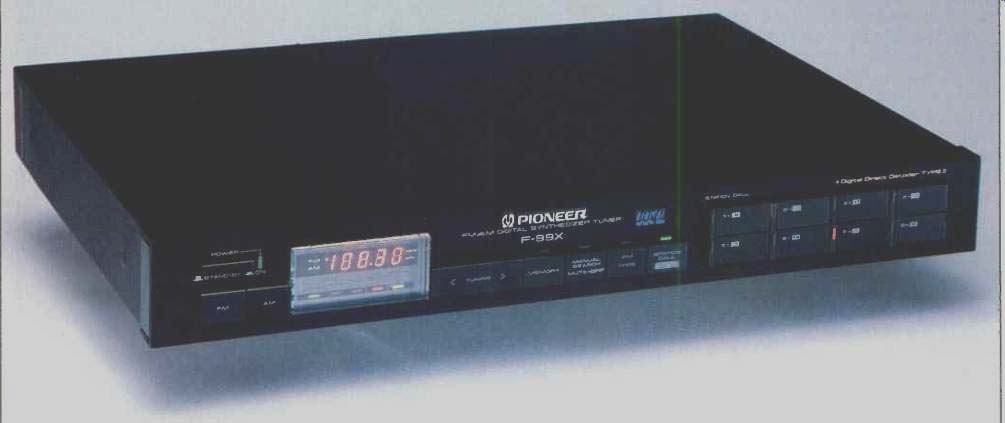
Manufacturer's Specifications
FM Tuner Section
Usable Sensitivity, Narrow-Band: Mono, 10.8 dBf.
50-dB Quieting Sensitivity, Narrow-Band: Mono, 12.8 dBf; stereo, 34.8 dBf.
S/N Ratio: Mono, 94 dB at 80 dBf; stereo, 87 dB at 80 dBf.
Alternate-Channel Selectivity, Narrow-Band: 85 dB.
Capture Ratio, Wide-Band: 0.8 dB.
THD, Wide-Band: Mono, 0.0095% at 1 kHz, 0.015% at 100 Hz, and 0.02% at 6 kHz; stereo, 0.02% at 1 kHz, 0.02% at 100 Hz, and 0.07% at 6 kHz.
THD, Narrow-Band: Mono, 0.09% at 1 kHz; stereo, 0.5% at 1 kHz.
Stereo Separation, Wide-Band: 65 dB at 1 kHz, 55 dB from 20 Hz to 10 kHz.
Frequency Response: 20 Hz to 15 kHz, +0.2 dB,-0.8 dB.
I.f. Rejection: 100 dB.
Image Rejection: 70 dB.
Spurious Response Rejection: 80 dB.
Subcarrier Rejection: 60 dB.
Muting Threshold: 25.2 dBf.
Output Level: 650 mV at 100% modulation.
AM Tuner Section
Sensitivity: 150 uV/m (with loop antenna).
Selectivity: 18 dB.
S/N Ratio: 50 dB.
Image Rejection: 40 dB.
I.f. Rejection: 60 dB.
Output Level: 150 mV at 30% modulation.
General Specifications
Power Consumption: 120 V a.c., 20 watts.
Dimensions: 18 in. W x 2 1/2 in. H x 12-5/16 in. D (45.7 cm x 6.4 cm x 31.3 cm).
Weight: 9 lbs., 15 oz. (4.5 kg).
Price: $324.95.
Company Address: P.O. Box 1760, Long Beach, Cal. 90801. USA.
Pioneer tuners have always enjoyed a good reputation among devotees of good FM radio. Witness the series of "Super Tuners" that Pioneer pioneered (sorry!) several years ago for car sound systems. The current "Super Tuners" are still considered by many to be the standard by which other car-stereo tuners should be judged. It stands to reason that a company that can do such a good job of designing a tuner for the hostile electrical and physical environment of an automobile should be able to do an equally fine job in designing one for home use. Pioneer has done just that with their F-99X.
One of the chief virtues of the F-99X is its dual i f. band width, which is switchable from wide to narrow. Many other manufacturers have employed this scheme of trading off selectivity for lower distortion and better separation, but the bandwidths Pioneer has chosen make the most of this idea.
The unit, like most recent AM/FM tuners, employs frequency-synthesized tuning, which has also been designed to near perfection. Unlike designs of the earliest synthesized models, the F-99X's use of this crystal-accurate method of tuning has not in any way degraded its signal-to-noise ratio or distortion capabilities. My only quarrel with Pioneer's description of the F-99X is in their use of the word "digital"; I'm not sure what's digital about this fine product, other than the legible frequency display which does, indeed, show tuned-to AM or FM frequencies in numbers-or "digits." To keep the front panel slim and uncluttered, and yet provide an adequate number of station presets, Pioneer makes use of the now-familiar "shift key" approach. The eight preset buttons, with the aid of a "Station Call" mode key, allow you to program or memorize a total of 16 AM or FM stations. What's more, when you want to recall these stations, it's not necessary to specify whether they are on the AM or FM band. Of course, you can preset AM and FM stations in any order you wish, but if you program the first eight on the FM band with "Station Call" in its out position, and then program the next eight as AM stations with "Station Call" in its depressed position, this key then serves the purpose of switching bands as well as stations. The F-99X will remember the station to which you are tuned when you turn off the power, and will access that frequency when power is turned on again. Even if the power cord is disconnected or there is a power outage (up to three days or so), a charged capacitor inside the tuner will power the memory function so station presets will not be lost.
Control Layout
The "Power" on/off pushbutton, together with its indicator light, is at the upper left corner of the tuner's slim front panel. "FM" and "AM" selector buttons are located below the power switch, and to the right is an LED display area that shows tuned-to frequencies, the selected band (AM or FM), signal strength (by means of three small LEDs), selection of the "Narrow" i.f. mode, and stereo reception.
The "Tuning" rocker bar, to the right of the display, raises or lowers the tuned frequency till the F-99X intercepts the next acceptably strong signal. The same bar can also tune the F-99X up or down the dial in increments of 0.1 MHz (FM) or 10 kHz (AM), if the "Manual Search" button is pressed.
Memorizing a station's frequency is accomplished by pressing the "Memory" button, adjacent to the "Tuning" bar, and then pressing one of the numbered preset buttons at the panel's far right. The i.f. mode-selector and "Station Call" buttons are to the right of "Memory" and "Manual Search." An LED above each of these four controls shows when it is activated.
The "Manual Search" button has a second function: Switching to manual tuning also turns the FM muting off.
You're more likely to use the manual tuning mode to seek out weak stations, which automatic tuning might skip and muting might make inaudible. So Pioneer's arrangement makes more sense than the more common one of yoking the mono/stereo switch to the muting. The latter practice has, more than once, kept me from listening to a fairly weak station in stereo, even though I was willing to tolerate the extra noise. I dislike having to switch into mono to defeat a muting circuit, especially when its threshold is set too high, as often happens.
I'd like to credit Pioneer with having carefully thought out the most desirable location for the mute defeat switch, but I should note that it may have been the only place they could put it, since this tuner does not have a mono/stereo switch.
The omission is not really much of a problem. If you encounter a very noisy stereo station (one strong enough to over come the stereo threshold of the tuner but not strong enough to be noise-free), you can always switch to mono on your preamplifier or amplifier. Doing so cancels cut most of the objectionable noise that is normally out of phase in the left and right channels.
The F-99X's rear panel is equipped with the usual left and right output jacks; a 75-ohm, coaxial FM-antenna connector, and a pair of spring-clip terminals for the separate AM loop antenna, supplied, or an outdoor AM antenna. If you want to use a 300-ohm, flat twin-lead for connecting your FM antenna, you will have to connect it to the 300-ohm/75-ohm transformer that is provided. The version of the F-99X sup plied to the United States is also equipped with an output jack labeled "AM Stereo," but no details are given regarding its "tap-in" point. Since I do not have an AM stereo decoder (either for the Kahn-Hazeltine or the Motorola system), I can't say whether this jack serves its purpose.
Measurements
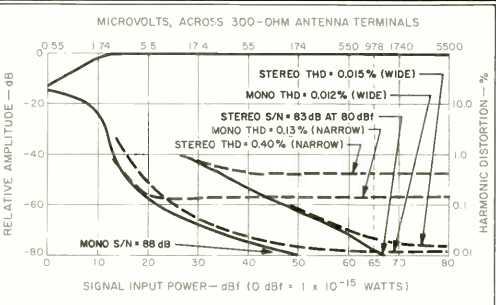
Fig. 1--FM mono and stereo distortion in wide and narrow i.f. modes, and quieting
in wide mode only.
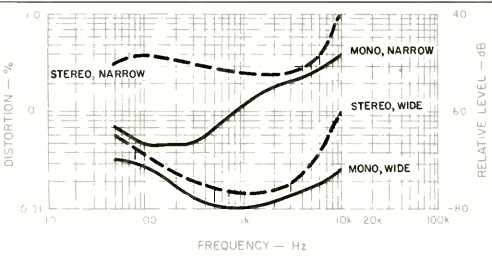
Fig. 2--THD vs. frequency, FM section.

Fig. 3--FM frequency response (top trace) and separation vs. frequency for
narrow i.f. mode (middle trace) and wide I.f. mode (bottom trace).
Figure 1 shows the tuner's FM quieting and 1-kHz distortion characteristics and, by implication, its sensitivity. Us able sensitivity was 10.8 dBf in the narrow mode, exactly as claimed, but in the wide i.f. mode, as might be expected, usable sensitivity was slightly poorer, 14 dBf. The 50-dB quieting sensitivity in mono, in the narrow mode, was 13 dBf, actually better than claimed. In stereo, I measured 36 dBf for the 50-dB quieting point, regardless of the i.f. mode.
Since quieting characteristics were very nearly the same in either i.f. mode, once signal strengths exceeded the low usable-sensitivity figures, I saw no point in showing quieting for both modes.
In the wide i.f. mode, I measured a maximum signal-to noise ratio of 88 dB in mono, but I suspect that this result was limited by my test equipment. The same holds true for he wide-mode measurement of THD at 1 kHz in mono, where I obtained a reading of 0.012%. The fact is that the accuracy of my signal generator, as good as it is, is guaranteed only to 0.01% distortion and to a residual-noise figure of around 90 dB. I would therefore not dispute Pioneer's claimed S/N of 94 dB, in mono, or THD of 0.0095%, also in mono. (I just wish I knew how they measured these low figures!) My tests showed, dramatically, the trade-offs that occur when a tuner has a well-designed wide/narrow i.f. choice.
Switching to the narrow mode resulted in a very substantial improvement in selectivity; it measured just over 83 dB in his mode, compared to less than 50 dB in the wide mode. But as you can see in Fig. 1, distortion increased in the narrow mode by more than a whole order of magnitude, measuring 0.13% in mono and 0.4% in stereo for a 1-kHz test signal.
The differences in distortion produced by the tuner in its two i.f. modes are further illustrated by the curves of Fig. 2. Here, I have plotted distortion as a function of frequency, from 50 Hz to 10 kHz, for both mono and stereo operation of each of the two i.f. modes. Stereo separation, shown in Fig. 3, is also affected by the choice of i.f. modes. While in the wide mode, I measured separation of 60 dB (the highest I can measure reliably) at 1 kHz. Separation was very nearly as good at the frequency extremes, with readings of 59 dB at 100 Hz and an incredibly high 53 dB at 10 kHz. Switching to the narrow i.f. mode resulted in separation figures which, although still more than adequate, clearly illustrate what a narrower i.f. bandwidth does to even the most carefully designed and well-aligned multiplex decoder circuitry. Now, separation measured 46 dB at mid-frequencies, decreasing to 44 dB at 100 Hz and 40 dB at 10 kHz.
There are also differences, between the wide and narrow i.f. modes, in separation and crosstalk components created when a 5-kHz signal is used to modulate one channel 100%; this is evident from the spectrum analysis photos of Figs. 4A and 4B. Notice the higher amplitude crosstalk and distortion products that show up to the right of the desired 5-kHz (large) spike in Fig. 4B, compared with those appearing in Fig. 4A.
Overall frequency response was flat within 0.2 dB from 50 Hz to 10 kHz and was down 0.8 dB at 15 kHz, as claimed.
Frequency response (in stereo), as well as channel separation for both i.f. operating modes, is shown in the spectrum analysis sweeps of Fig. 3. The frequency sweep is logarithmic from 20 Hz to 20 kHz, and the vertical scale is 10 dB per division.
The muting threshold was set to just under 30 dBf--an Ideal point for this tuner, in my opinion. At 30 dBf, the F-99X's stereo signal-to-noise ratio has reached an acceptable level of 44 dB.-he stereo switching threshold was set almost to the same point, 27 dBf-again an ideal choice.
Therefore, when you are in the automatic tuning mode, the frequency-synthesized tuner will deliver only incoming stereo signals that are quiet enough to be enjoyed. If you want to listen to weaker stereo (or mono) stations, you'll simply have to tune to those stations manually and thereby defeat the muting circuitry.
Capture ratio, measured in the wide i.f. mode, was 1.0 dB. Subcarrier rejection was 61.5 dB on one channel and 65 dB on the other. SCA rejection was greater than 75 dB, and image rejection measured 71 dB. Spurious response rejection, measured in the wide mode, was greater than 85 dB, and AM suppression measured 67 dB-one of the highest readings I have ever been able to obtain for this important parameter. I.f. reject on was 100 dB or greater (my test setup would have difficulty reading anything over 100 dB).
After plotting AM frequency response (Fig. 5), I didn't spend too much time measuring other characteristics of the AM section. I suppose if you wanted to apply the very liberal tolerance of ±6.0 dB to the frequency response, you could say that it extended from around 50 Hz to 6 kHz. On the other hand, if you arbitrarily call the 1-kHz output "0 dB," then the-6 dB points would have to be stated as occurring at around 60 Hz and 4 kHz. In either case, the narrow bandwidth of the AM section makes me doubt whether any type of AM stereo adaptor would work successfully when connected to the rear panel's "AM Stereo" jack. I suspect that owners of this excellent tuner won't care one way or the other about AM stereo in any case.
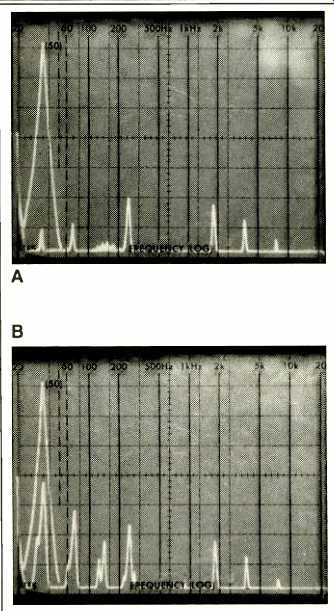
Fig. 4--Separation, crosstalk, and distortion components for 5-kHz left-only
modulating signal in wide (A) and narrow (B) i.f. modes, FM section.
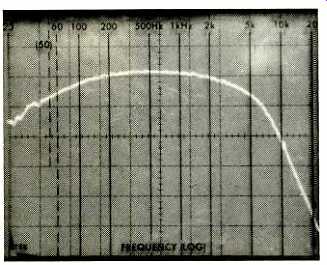
Fig. 5--AM frequency response.
Use and Listening Tests
When connected to my outdoor rotatable antenna, the Pioneer F-99X tuner successfully picked up every FM station that I have ever logged in my listening area. This added up to some 60 usable signals, plus a marginally unacceptable few that were 100 miles or more away. You couldn't ask for much more by way of FM sensitivity in an FM tuner. Even more impressive was the ultra-low distortion. Yes, you can hear the difference, especially when you tune to stations that habitually over-modulate and sound terrible on tuners of lesser quality.
There were a few stations far enough away from the broadcasters in my area to have been assigned adjacent channel frequencies, and these were nicely locked in by switching to the narrow mode. Equally sensitive tuners I have tested were unable to zero in on those stations: Even in their narrow i.f. settings, they just didn't have enough adjacent-channel rejection. Pioneer, as I suspected during the bench tests, has set the narrow and wide i.f. bandwidths where they will do the most good.
I found that I hardly needed to refer to the owner's manual when testing or listening to this tuner. The control layout is very logical and easy to understand. I could argue that the "Memory" pushbutton, required for entering a frequency into one of the preset locations, might have been better positioned near the preset buttons instead of near the "Tuning" rocker, but that's really a minor point.
After I had finished my listening tests, I mounted the two wood-grain side panels that came with the tuner. These panels did indeed dress up what is otherwise a rather stark and plain-looking housing. For the kind of FM reception I was able to get from the F-99X, and considering its very reasonable price, I wouldn't have been too upset even if Pioneer had chosen not to throw in those wood side panels.
-Leonard Feldman
( Audio magazine, Nov. 1985)
Also see:
Pioneer Elite F-91 Tuner (Equip. Profile, Aug. 1988)
Pioneer Elite PD-65 CD Player (Dec. 1992)
= = = =